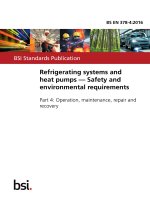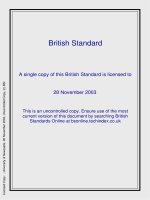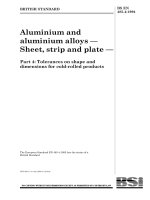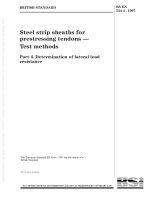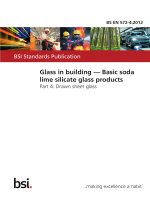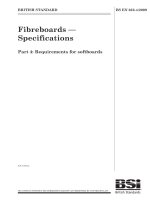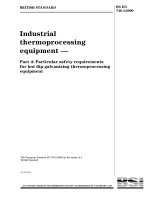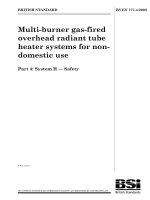Bsi bs en 61158 4 20 2014
Bạn đang xem bản rút gọn của tài liệu. Xem và tải ngay bản đầy đủ của tài liệu tại đây (2.1 MB, 46 trang )
BS EN 61158-4-20:2014
BSI Standards Publication
Industrial communication
networks — Fieldbus
specifications
Part 4-20: Data-link layer protocol
specification — Type 20 elements
BRITISH STANDARD
BS EN 61158-4-20:2014
National foreword
This British Standard is the UK implementation of EN 61158-4-20:2014. It is
identical to IEC 61158-4-20:2014.
The UK participation in its preparation was entrusted to Technical
Committee AMT/7, Industrial communications: process measurement
and control, including fieldbus.
A list of organizations represented on this committee can be obtained on
request to its secretary.
This publication does not purport to include all the necessary provisions of
a contract. Users are responsible for its correct application.
© The British Standards Institution 2014.
Published by BSI Standards Limited 2014
ISBN 978 0 580 79448 3
ICS 25.040.40; 35.100.20; 35.110
Compliance with a British Standard cannot confer immunity from
legal obligations.
This British Standard was published under the authority of the
Standards Policy and Strategy Committee on 30 November 2014.
Amendments/corrigenda issued since publication
Date
Text affected
EUROPEAN STANDARD
EN 61158-4-20
NORME EUROPÉENNE
EUROPÄISCHE NORM
October 2014
ICS 25.040.40; 35.100.20; 35.110
English Version
Industrial communication networks - Fieldbus specifications Part 4-20: Data-link layer protocol specification - Type 20
elements
(IEC 61158-4-20:2014)
Réseaux de communication industriels - Spécifications des
bus de terrain - Partie 4-20: Spécification du protocole de la
couche liaison de données - Éléments de type 20
(CEI 61158-4-20:2014)
Industrielle Kommunikationsnetze - Feldbusse - Teil 4-20:
Protokollspezifikation des Data Link Layer
(Sicherungsschicht) - Typ 20-Elemente
(IEC 61158-4-20:2014)
This European Standard was approved by CENELEC on 2014-09-19. CENELEC members are bound to comply with the CEN/CENELEC
Internal Regulations which stipulate the conditions for giving this European Standard the status of a national standard without any alteration.
Up-to-date lists and bibliographical references concerning such national standards may be obtained on application to the CEN-CENELEC
Management Centre or to any CENELEC member.
This European Standard exists in three official versions (English, French, German). A version in any other language made by translation
under the responsibility of a CENELEC member into its own language and notified to the CEN-CENELEC Management Centre has the
same status as the official versions.
CENELEC members are the national electrotechnical committees of Austria, Belgium, Bulgaria, Croatia, Cyprus, the Czech Republic,
Denmark, Estonia, Finland, Former Yugoslav Republic of Macedonia, France, Germany, Greece, Hungary, Iceland, Ireland, Italy, Latvia,
Lithuania, Luxembourg, Malta, the Netherlands, Norway, Poland, Portugal, Romania, Slovakia, Slovenia, Spain, Sweden, Switzerland,
Turkey and the United Kingdom.
European Committee for Electrotechnical Standardization
Comité Européen de Normalisation Electrotechnique
Europäisches Komitee für Elektrotechnische Normung
CEN-CENELEC Management Centre: Avenue Marnix 17, B-1000 Brussels
© 2014 CENELEC All rights of exploitation in any form and by any means reserved worldwide for CENELEC Members.
Ref. No. EN 61158-4-20:2014 E
BS EN 61158-4-20:2014
EN 61158-4-20:2014
-2-
Foreword
The text of document 65C/762/FDIS, future edition 1 of IEC 61158-4-20, prepared by SC 65C
“Industrial networks” of IEC/TC 65 “Industrial-process measurement, control and automation" was
submitted to the IEC-CENELEC parallel vote and approved by CENELEC as EN 61158-4-20:2014.
The following dates are fixed:
•
latest date by which the document has
to be implemented at national level by
publication of an identical national
standard or by endorsement
(dop)
2015-06-19
•
latest date by which the national
standards conflicting with the
document have to be withdrawn
(dow)
2017-09-19
Attention is drawn to the possibility that some of the elements of this document may be the subject of
patent rights. CENELEC [and/or CEN] shall not be held responsible for identifying any or all such
patent rights.
This document has been prepared under a mandate given to CENELEC by the European Commission
and the European Free Trade Association.
Endorsement notice
The text of the International Standard IEC 61158-4-20:2014 was approved by CENELEC as a
European Standard without any modification.
In the official version, for bibliography, the following notes have to be added for the standards
indicated:
IEC 61158-1:2014
NOTE
Harmonised as EN 61158-1:2014
IEC 61158-3-20:2014
NOTE
Harmonised as EN 61158-3-20:2014
IEC 61158-5-20:2014
NOTE
Harmonised as EN 61158-5-20:2014
IEC 61784-1
NOTE
Harmonised as EN 61784-1
IEC 61784-2
NOTE
Harmonised as EN 61784-2
IEC 62591:2010
NOTE
Harmonised as EN 62591:2010
BS EN 61158-4-20:2014
EN 61158-4-20:2014
-3-
Annex ZA
(normative)
Normative references to international publications
with their corresponding European publications
The following documents, in whole or in part, are normatively referenced in this document and are
indispensable for its application. For dated references, only the edition cited applies. For undated
references, the latest edition of the referenced document (including any amendments) applies.
NOTE 1 When an International Publication has been modified by common modifications, indicated by (mod), the relevant
EN/HD applies.
NOTE 2 Up-to-date information on the latest versions of the European Standards listed in this annex is available here:
www.cenelec.eu.
Publication
Year
Title
EN/HD
Year
IEC 61158-2
2014
Industrial communication networks Fieldbus specifications
Part 2: Physical layer specification and
service definition
EN 61158-2
2014
IEC 61158-6-20
2014
Industrial communication networks Fieldbus specifications
Part 6-20: Application layer protocol
specification - Type 20 elements
EN 61158-6-20
2014
ISO/IEC 7498-1
-
Information technology - Open Systems
Interconnection - Basic reference model: The
basic model
-
ISO/IEC 7498-3
-
Information technology - Open Systems
Interconnection - Basic reference model:
Naming and addressing
-
-
ISO/IEC 10731
-
Information technology - Open Systems
Interconnection - Basic Reference Model Conventions for the definition of OSI
services
-
-
–2–
BS EN 61158-4-20:2014
IEC 61158-4-20:2014 © IEC 2014
CONTENTS
INTRODUCTION ..................................................................................................................... 6
1
Scope ............................................................................................................................... 7
2
1.1 General ................................................................................................................... 7
1.2 Specifications .......................................................................................................... 7
1.3 Procedures .............................................................................................................. 7
1.4 Applicability ............................................................................................................. 7
1.5 Conformance ........................................................................................................... 7
Normative references ....................................................................................................... 8
3
Terms, definitions, symbols and abbreviations .................................................................. 8
3.1
3.2
3.3
3.4
3.5
4
Reference model terms and definitions .................................................................... 8
Service convention terms and definitions ................................................................. 9
Common terms and definitions .............................................................................. 10
Additional Type 20 definitions ................................................................................ 12
Common symbols and abbreviations ..................................................................... 18
3.5.1 Data units .................................................................................................. 18
3.5.2 Miscellaneous ............................................................................................ 18
3.6 Additional Type 20 symbols and abbreviations ...................................................... 19
Data-link layer protocol specification .............................................................................. 20
4.1
4.2
Overview ............................................................................................................... 20
Parameters, timers and variables .......................................................................... 21
4.2.1 Parameters ................................................................................................ 21
4.2.2 Timers ....................................................................................................... 22
4.2.3 Variables ................................................................................................... 22
4.3 Logical link control ................................................................................................ 23
4.3.1 General DLPDU structure .......................................................................... 23
4.3.2 DLPDU specific encoding and procedures ................................................. 26
4.3.3 Framing ..................................................................................................... 27
4.3.4 Error detection ........................................................................................... 27
4.3.5 Slave response to communication error ..................................................... 28
4.4 Medium access control .......................................................................................... 30
4.4.1 Overview ................................................................................................... 30
4.4.2 Master controlled medium access .............................................................. 31
4.4.3 Burst mode controlled medium access ....................................................... 32
4.4.4 Token passing summary ............................................................................ 32
4.4.5 XMIT machine ........................................................................................... 33
4.4.6 RECV machine .......................................................................................... 34
4.4.7 Slave MAC machine .................................................................................. 35
4.4.8 Master MAC machine ................................................................................ 38
4.5 DL-management-information ................................................................................. 41
Bibliography .......................................................................................................................... 42
Figure 1 – Relationships of DLSAPs, DLSAP-addresses and group DL-addresses ................ 11
Figure 2 – DLPDU Structure ................................................................................................. 23
Figure 3 – Delimiter Structure ............................................................................................... 23
Figure 4 – Construction of 1-octet address field .................................................................... 24
BS EN 61158-4-20:2014
IEC 61158-4-20:2014 © IEC 2014
–3–
Figure 5 – Construction of 5-octet address field .................................................................... 25
Figure 6 – APDU format ........................................................................................................ 25
Figure 7 – DLPDU framing .................................................................................................... 27
Figure 8 – Two dimensional parity detection ......................................................................... 28
Figure 9 – Communication error response DLL payload ........................................................ 29
Figure 10 – MAC state machines .......................................................................................... 31
Figure 11 – Master controlled medium access ...................................................................... 31
Figure 12 – Burst mode controlled medium access ............................................................... 32
Figure 13 – XMIT state machine ........................................................................................... 33
Figure 14 – RECV state machine .......................................................................................... 34
Figure 15 – Slave MAC state machine .................................................................................. 36
Figure 16 – Master MAC state machine ................................................................................ 38
Table 1 – Slave response to communication error ................................................................. 29
Table 2 – Communication error code values ......................................................................... 29
Table 3 – Token passing ....................................................................................................... 32
Table 4 – XMIT state transitions ........................................................................................... 33
Table 5 – RECV state transitions .......................................................................................... 35
Table 6 – Slave MAC state transitions .................................................................................. 37
Table 7 – Master MAC state transitions................................................................................. 39
Table 8 – Master DL parameters ........................................................................................... 41
Table 9 – Slave DL parameters ............................................................................................. 41
–6–
BS EN 61158-4-20:2014
IEC 61158-4-20:2014 © IEC 2014
INTRODUCTION
This part of IEC 61158 is one of a series produced to facilitate the interconnection of
automation system components. It is related to other standards in the set as defined by the
“three-layer” fieldbus reference model described in IEC 61158-1.
The data-link protocol provides the data-link service by making use of the services available
from the physical layer. The primary aim of this standard is to provide a set of rules for
communication expressed in terms of the procedures to be carried out by peer data-link
entities (DLEs) at the time of communication. These rules for communication are intended to
provide a sound basis for development in order to serve a variety of purposes:
a) as a guide for implementors and designers;
b) for use in the testing and procurement of equipment;
c) as part of an agreement for the admittance of systems into the open systems environment;
d) as a refinement to the understanding of time-critical communications within OSI.
This standard is concerned, in particular, with the communication and interworking of sensors,
effectors and other automation devices. By using this standard together with other standards
positioned within the OSI or fieldbus reference models, otherwise incompatible systems may
work together in any combination.
BS EN 61158-4-20:2014
IEC 61158-4-20:2014 © IEC 2014
–7–
INDUSTRIAL COMMUNICATION NETWORKS –
FIELDBUS SPECIFICATIONS –
Part 4-20: Data-link layer protocol specification –
Type 20 elements
1
1.1
Scope
General
The data-link layer provides basic time-critical messaging communications between devices in
an automation environment.
This protocol provides a means of connecting devices through a partial mesh network, such
that most failures of an interconnection between two devices can be circumvented. In
common practice the devices are interconnected in a non-redundant hierarchical manner
reflecting application needs
1.2
Specifications
This International Standard specifies
a) procedures for the timely transfer of data and control information from one data-link user
entity to a peer user entity, and among the data-link entities forming the distributed datalink service provider;
b) the structure of the fieldbus DLPDUs used for the transfer of data and control information
by the protocol of this standard, and their representation as physical interface data units.
1.3
Procedures
The procedures are defined in terms of
a) the interactions between peer DL-entities (DLEs) through the exchange of fieldbus
DLPDUs;
b) the interactions between a DL-service (DLS) provider and a DLS-user in the same system
through the exchange of DLS primitives;
c) the interactions between a DLS-provider and a Ph-service provider in the same system
through the exchange of Ph-service primitives.
1.4
Applicability
These procedures are applicable to instances of communication between systems which
support time-critical communications services within the data-link layer of the OSI or fieldbus
reference models, and which require the ability to interconnect in an open systems
interconnection environment.
Profiles provide a simple multi-attribute means of summarizing an implementation’s
capabilities, and thus its applicability to various time-critical communications needs.
1.5
Conformance
This International Standard also specifies conformance requirements for systems
implementing these procedures. This standard does not contain tests to demonstrate
compliance with such requirements.
–8–
2
BS EN 61158-4-20:2014
IEC 61158-4-20:2014 © IEC 2014
Normative references
The following documents, in whole or in part, are normatively referenced in this document and
are indispensable for its application. For dated references, only the edition cited applies. For
undated references, the latest edition of the referenced document (including any
amendments) applies.
NOTE All parts of the IEC 61158 series, as well as IEC 61784-1 and IEC 61784-2 are maintained simultaneously.
Cross-references to these documents within the text therefore refer to the editions as dated in this list of normative
references.
IEC 61158-2:2014, Industrial communication networks – Fieldbus specifications – Part 2:
Physical layer specification and service definition
IEC 61158-6-20:2014, Industrial communication networks – Fieldbus specifications – Part 620: Application layer protocol specification – Type 20 elements
ISO/IEC 7498-1, Information technology – Open Systems Interconnection – Basic Reference
Model: The Basic Model
ISO/IEC 7498-3, Information technology – Open Systems Interconnection – Basic Reference
Model: Naming and addressing
ISO/IEC 10731, Information technology – Open Systems Interconnection – Basic Reference
Model – Conventions for the definition of OSI services
3
Terms, definitions, symbols and abbreviations
For the purposes of this document, the following terms, definitions, symbols, abbreviations
and conventions apply.
3.1
Reference model terms and definitions
This standard is based in part on the concepts developed in ISO/IEC 7498-1 and
ISO/IEC 7498-3, and makes use of the following terms defined therein:
3.1.1
3.1.2
3.1.3
3.1.4
3.1.5
3.1.6
3.1.7
3.1.8
3.1.9
3.1.10
3.1.11
3.1.12
3.1.13
3.1.14
3.1.15
3.1.16
3.1.17
3.1.18
3.1.19
3.1.20
3.1.21
called-DL-address
calling-DL-address
centralized multi-end-point-connection
correspondent (N)-entities
correspondent DL-entities (N=2)
correspondent Ph-entities (N=1)
demultiplexing
DL-address
DL-address-mapping
DL-connection
DL-connection-end-point
DL-connection-end-point-identifier
DL-connection-mode transmission
DL-connectionless-mode transmission
DL-data-sink
DL-data-source
DL-duplex-transmission
DL-facility
DL-local-view
DL-name
DL-protocol
DL-protocol-connection-identifier
DL-protocol-control-information
[7498-3]
[7498-3]
[7498-1]
[7498-1]
[7498-1]
[7498-3]
[7498-1]
[7498-1]
[7498-1]
[7498-1]
[7498-1]
[7498-1]
[7498-1]
[7498-1]
[7498-1]
[7498-1]
[7498-3]
[7498-3]
[7498-1]
[7498-1]
[7498-1]
BS EN 61158-4-20:2014
IEC 61158-4-20:2014 © IEC 2014
3.1.22
3.1.23
3.1.24
3.1.25
3.1.26
3.1.27
3.1.28
3.1.29
3.1.30
3.1.31
3.1.32
3.1.33
3.1.34
3.1.35
3.1.36
3.1.37
3.1.38
3.1.39
3.1.40
3.1.41
3.1.42
3.1.43
3.1.44
3.1.45
3.1.46
3.1.47
3.1.48
3.1.49
3.1.50
3.1.51
3.1.52
3.1.53
3.1.54
3.1.55
3.2
–9–
DL-protocol-data-unit
DL-protocol-version-identifier
DL-relay
DL-service-connection-identifier
DL-service-data-unit
DL-simplex-transmission
DL-subsystem
DL-user-data
flow control
layer-management
multiplexing
naming-(addressing)-authority
naming-(addressing)-domain
naming-(addressing)-subdomain
(N)-entity
DL-entity
Ph-entity
(N)-interface-data-unit
DL-service-data-unit
Ph-interface-data-unit (N=1)
(N)-layer
DL-layer
Ph-layer (N=1)
(N)-service
DL-service
Ph-service (N=1)
(N)-service-access-point
DL-service-access-point
Ph-service-access-point (N=1)
(N)-service-access-point-address
DL-service-access-point-address
Ph-service-access-point-address (N=1)
peer-entities
Ph-interface-control-information
Ph-interface-data
primitive name
reassembling
recombining
reset
responding-DL-address
routing
segmenting
sequencing
splitting
synonymous name
systems-management
[7498-1]
[7498-1]
[7498-1]
[7498-1]
[7498-1]
[7498-1]
[7498-1]
[7498-1]
[7498-1]
[7498-1]
[7498-3]
[7498-3]
[7498-3]
[7498-3]
[7498-1]
(N=2)
(N=2)
(N=2)
(N=2)
(N=2)
[7498-1]
[7498-1]
[7498-1]
[7498-1]
[7498-1]
[7498-1]
[7498-1]
[7498-1]
[7498-3]
[7498-1]
[7498-1]
[7498-1]
[7498-3]
[7498-1]
[7498-1]
[7498-1]
[7498-1]
[7498-3]
[7498-1]
Service convention terms and definitions
This standard also makes use of the following terms defined in ISO/IEC 10731 as they apply
to the data-link layer:
3.2.1
3.2.2
3.2.3
3.2.4
3.2.5
3.2.6
3.2.7
3.2.8
acceptor
asymmetrical service
confirm (primitive);
requestor.deliver (primitive)
deliver (primitive)
DL-confirmed-facility
DL-facility
DL-local-view
DL-mandatory-facility
– 10 –
3.2.9
3.2.10
3.2.11
3.2.12
3.2.13
3.2.14
3.2.15
3.2.16
3.2.17
3.2.18
3.2.19
3.2.20
3.2.21
3.2.22
3.3
BS EN 61158-4-20:2014
IEC 61158-4-20:2014 © IEC 2014
DL-non-confirmed-facility
DL-provider-initiated-facility
DL-provider-optional-facility
DL-service-primitive;
primitive
DL-service-provider
DL-service-user
DLS-user-optional-facility
indication (primitive);
acceptor.deliver (primitive)
multi-peer
request (primitive);
requestor.submit (primitive)
requestor
response (primitive);
acceptor.submit (primitive)
submit (primitive)
symmetrical service
Common terms and definitions
For the purposes of this document, the following terms and definitions apply.
NOTE Many definitions are common to more than one protocol Type; they are not necessarily used by all protocol
Types.
3.3.1
DL-segment,
link,
local link
single DL-subnetwork in which any of the connected DLEs may communicate directly, without
any intervening DL-relaying, whenever all of those DLEs that are participating in an instance
of communication are simultaneously attentive to the DL-subnetwork during the period(s) of
attempted communication
3.3.2
DLSAP
distinctive point at which DL-services are provided by a single DL-entity to a single higherlayer entity
Note 1 to entry: This definition, derived from ISO/IEC 7498-1, is repeated here to facilitate understanding of the
critical distinction between DLSAPs and their DL-addresses, see Figure 1.
BS EN 61158-4-20:2014
IEC 61158-4-20:2014 © IEC 2014
– 11 –
NOTE 1
DLSAPs and PhSAPs are depicted as ovals spanning the boundary between two adjacent layers.
NOTE 2
DL-addresses are depicted as designating small gaps (points of access) in the DLL portion of a DLSAP.
NOTE 3 A single DL-entity may have multiple DLSAP-addresses and group DL-addresses associated with a
single DLSAP.
Figure 1 – Relationships of DLSAPs, DLSAP-addresses and group DL-addresses
3.3.3
DL(SAP)-address
either an individual DLSAP-address, designating a single DLSAP of a single DLS-user, or a
group DL-address potentially designating multiple DLSAPs, each of a single DLS-user
Note 1 to entry: This terminology is chosen because ISO/IEC 7498-3 does not permit the use of the term DLSAPaddress to designate more than a single DLSAP at a single DLS-user.
3.3.4
(individual) DLSAP-address
DL-address that designates only one DLSAP within the extended link
Note 1 to entry:
A single DL-entity may have multiple DLSAP-addresses associated with a single DLSAP.
3.3.5
extended link
DL-subnetwork, consisting of the maximal set of links interconnected by DL-relays, sharing a
single DL-name (DL-address) space, in which any of the connected DL-entities may
communicate, one with another, either directly or with the assistance of one or more of those
intervening DL-relay entities
Note 1 to entry:
An extended link may be composed of just a single link.
3.3.6
frame
denigrated synonym for DLPDU
– 12 –
BS EN 61158-4-20:2014
IEC 61158-4-20:2014 © IEC 2014
3.3.7
group DL-address
DL-address that potentially designates more than one DLSAP within the extended link
Note 1 to entry: A single DL-entity may have multiple group DL-addresses associated with a single DLSAP. A
single DL-entity also may have a single group DL-address associated with more than one DLSAP.
3.3.8
node
single DL-entity as it appears on one local link
3.3.9
receiving DLS-user
DL-service user that acts as a recipient of DLS-user-data
Note 1 to entry:
A DL-service user can be concurrently both a sending and receiving DLS-user.
3.3.10
sending DLS-user
DL-service user that acts as a source of DLS-user-data
3.4
Additional Type 20 definitions
3.4.1
analog controller
controller designed for use with only 4 mA to 20 mA current signaling that meets all
requirements of a current input device or current output device
3.4.2
analog signal
low frequency current, predominantly 4 mA to 20 mA signal sent to or originating from a field
device
3.4.3
analog signal spectrum
frequencies from zero to 25 Hz at unit amplitude and decreasing at 40 dB per decade above
25 Hz
3.4.4
analog test filter
two-pole low-pass Butterworth filter with the cutoff frequency of 25 Hz
3.4.5
application
function or data structure for which data is consumed or produced
3.4.6
application object
object class that manages and provides the run time exchange of messages across the
network and within the network device
Note 1 to entry: Multiple types of application object classes may be defined.
3.4.7
application relationship
cooperative association between two or more application-entity-invocations for the purpose of
exchange of information and coordination of their joint operation
Note 1 to entry: This relationship is activated either by the exchange of application-protocol-data-units or as a
result of pre-configuration activities.
BS EN 61158-4-20:2014
IEC 61158-4-20:2014 © IEC 2014
– 13 –
3.4.8
application relationship endpoint
context and behaviour of an application relationship as seen and maintained by one of the
application processes involved in the application relationship
Note 1 to entry: Each application process involved in the application relationship maintains its own application
relationship endpoint.
3.4.9
attribute
description of an externally visible characteristic or feature of an object
Note 1 to entry: The attributes of an object contain information about variable portions of an object. Typically,
they provide status information or govern the operation of an object. Attributes may also affect the behavior of an
object. Attributes are divided into class attributes and instance attributes.
3.4.10
barrier
physical entity which limits current and voltage into a hazardous area in order to satisfy
intrinsic safety requirements
3.4.11
behavior
indication of how the object responds to particular events
3.4.12
broadcast
process of sending a PDU to all devices that are connected to the network and are able to
receive the transmission
3.4.13
broadcast address
address used by a master to send a command to all devices
3.4.14
burst mode
initiation of communication activity by a slave device at cyclic interval without request from a
master
3.4.15
cable capacitance per unit length
capacitance per unit length of cable, measured at 1 kHz from one conductor other than the
shield to all other conductors including the shield
Note 1 to entry: For networks comprised of more than one type or gauge of cable, the highest capacitance value of
any cable type or gauge is used to determine this value.
3.4.16
character
The 8-bits of data and overhead bits that are transmitted as one continuous unit by the PhE
3.4.17
character time
amount of time required to transmit one character
3.4.18
class
set of objects, all of which represent the same kind of system component
– 14 –
BS EN 61158-4-20:2014
IEC 61158-4-20:2014 © IEC 2014
Note 1 to entry: A class is a generalization of the object; a template for defining variables and methods. All
objects in a class are identical in form and behavior, but usually contain different data in their attributes.
3.4.19
class attributes
attribute that is shared by all objects within the same class
3.4.20
class code
unique identifier assigned to each object class
3.4.21
class specific service
service defined by a particular object class to perform a required function which is not
performed by a common service
Note 1 to entry:
A class specific object is unique to the object class which defines it.
3.4.22
client
a) object which uses the services of another (server) object to perform a task
b)
initiator of a message to which a server reacts, such as the role of an AR endpoint in
which it issues confirmed service request APDUs to a single AR endpoint acting as a
server
3.4.23
comm error
detectable error in receiving a PhPDU or DLPDU, also ‘Communication error code’ octet of
APDU
3.4.24
conveyance path
unidirectional flow of APDUs across an application relationship
3.4.25
current sense resistor
resistor that is used to convert analog current signal into a voltage signal
3.4.26
cyclic
term used to describe events which repeat in a regular and repetitive manner
3.4.27
delay distortion
difference in propagation time delays of sine waves of different frequencies when observing
the time delay through a network or circuit
3.4.28
device
any entity containing an implementation of this standard
3.4.29
device ID
serial number for a device that is unique among all instances of one type of device
Note 1 to entry: The manufacturer is required to assigned unique value for every device that has the identical
values for Manufacturer ID and Device Type.
BS EN 61158-4-20:2014
IEC 61158-4-20:2014 © IEC 2014
– 15 –
3.4.30
device type
manufacturer’s type of a device, e.g. its product name
Note 1 to entry:
The value of this attribute is assigned by the manufacturer. Its value specifies the set of
commands and data objects supported by the device. The manufacturer is required to assigned unique value to
each type of the device.
3.4.31
device variable
uniquely defined data item within a Field Device that is always associated with processrelated information
Note 1 to entry: A device variable's value varies in response to changes and variations in the process to which the
device is connected.
3.4.32
digital signal
communication of information using the 1 200 bits per second frequency shift keying signal
3.4.33
digital frequency band
range of frequencies from 950 Hz to 2 500 Hz that is used for digital signal
3.4.34
digital signal spectrum
frequencies from 500 Hz to 10 kHz at unit amplitude, decreasing at 40 dB per decade below
500 Hz and decreasing at 20 dB per decade above 10 kHz
3.4.35
dynamic variable
a device variable that is assigned as the dynamic variable and possibly associated with an
analog channel
Note 1 to entry: A device may contain up to four variables – primary, secondary, tertiary and quaternary. These
are collectively called the dynamic variables.
3.4.36
endpoint
one of the communicating entities involved in a connection
3.4.37
error
discrepancy between a computed, observed or measured value or condition and the specified
or theoretically correct value or condition
3.4.38
error code
identification of a specific type of error within an error class
3.4.39
expanded device type
manufacturer’s type of a device as specified in IEC 61158-6-20, Table 6
3.4.40
extended frequency band
range of frequencies from 500 Hz to 10 kHz
Note 1 to entry: This frequency band is digital frequency band plus guard band.
– 16 –
BS EN 61158-4-20:2014
IEC 61158-4-20:2014 © IEC 2014
3.4.41
field device
physical entity that is connected to the process or to plant equipment and has at least one
signalling element that communicates with other signalling element(s) via a cable
Note 1 to entry: It directly connects to the sensor or actuator or performs process control function and it is directly
connected to the physical layer specified in this standard. It may generate or receive an analog signal in addition to
a digital signal.
3.4.42
frame
format of aggregated bits that are transmitted together in time
3.4.43
ground
surface of the earth or the conduits or pipes that are so connected, or the safety bus bar or
the zero volt rail to which the barriers are connected
Note 1 to entry: Ground may or may not be the same as network power supply common.
3.4.44
intrinsic safety
design methodology for a circuit or an assembly of circuits in which any spark or thermal
effect produced under normal operating and specified fault conditions is not capable under
prescribed test conditions of causing ignition of a given explosive atmosphere
3.4.45
junction
any splice of two cables or any attachment point of another cable or of a field device to an
existing cable
3.4.46
long_tag
32 characters restricted ISO Latin-1 string used to identify a field device
3.4.47
loop current
value measured by a mA in series with the field device
Note 1 to entry: The loop current is a near DC analog 4 mA to 20 mA signal used to communicate a single value
between the control system and the field device. Voltage mode devices use "Volts DC" as their engineering units
where "loop current" values are used.
3.4.48
management information
network-accessible information that supports managing the operation of the fieldbus system,
including the application layer
Note 1 to entry:
Managing includes functions such as controlling, monitoring, and diagnosing.
3.4.49
manufacturer ID
2 octet enumeration identifying the manufacturer that produced a device
Note 1 to entry: A manufacturer is required to use the value assigned to it and is not permitted to use the value
assigned to another manufacturer.
3.4.50
master
device that initiates communication activity by sending request frame to another device and
expecting a response frame from that device
BS EN 61158-4-20:2014
IEC 61158-4-20:2014 © IEC 2014
– 17 –
3.4.51
message
information-bearing part, except the preamble part of the frame
3.4.52
multi-drop network
network with more than one slave device connected to one network
3.4.53
network
a single pair of cable, connectors, associated signaling elements by which a given set of
signaling devices are interconnected and non-signaling elements that are attached to the
same pair of cable
Note 1 to entry: An installation using multiple-pair wire and a common network power supply is considered as
multiple networks.
3.4.54
network power supply
source that supplies operating power directly to a network
3.4.55
network resistance
resistance or real part of the impedance of a network
Note 1 to entry: It is computed as the equivalent impedance of all devices connected in parallel to the network.
Therefore it is usually dominated by one low impedance device.
3.4.56
non-signaling element
physical entity or an element that does not use or produce analog signal or digital signal
Note 1 to entry: A network power supply is an example of non-signaling element.
3.4.57
payload data
contents of a data message that is being transmitted
3.4.58
point-to-point network
network with only one slave and zero or one master device
Note 1 to entry: The point-to-point Network need not have any master device. This situation would exist, for
example, when only an analog controller is used, the single field device having been programmed by a secondary
master that was subsequently disconnected.
3.4.59
polling address
identifier assigned to a device such that it is unique within the network to which the device is
connected
3.4.60
primary master
master device that can always initiate the communication
3.4.61
secondary master
master device that can initiate the communication only through an arbitration process and
when primary master has relinquished the initiation of the communication
– 18 –
BS EN 61158-4-20:2014
IEC 61158-4-20:2014 © IEC 2014
3.4.62
server
<communication> role of an AREP in which it returns a confirmed service response APDU to
the client that initiated the request
3.4.63
signaling element
physical entity or an element that uses or produces digital signal
3.4.64
silence
state of the network when there is no digital signal is present
3.4.65
slave
device that initiates communication activity only after it receives a request frame from a
master device and is required to send a response to that request
3.4.66
start of message
The preamble of physical layer PDU followed by the delimiter of data link layer PDU without
any reception error and inter-character gap
3.4.67
tag
8-character ASCII string used to identify a field device
3.4.68
transaction
exchange of related, consecutive frames between two peer medium access control entities,
required for a successful transmission
Note 1 to entry: A transaction consists of either (a) a single PhPDU transmission from a source device, or (b) one
PhPDU from the source device followed by a second, link-level acknowledgement PhPDU from the destination
device.
3.4.69
unique ID
identifier assigned to a device which is unique among all instances of the devices compliant to
this standard
3.5
Common symbols and abbreviations
NOTE Many symbols and abbreviations are common to more than one protocol Type; they are not necessarily
used by all protocol Types.
3.5.1
Data units
3.5.1.1
DLPDU
DL-protocol data unit
3.5.1.2
DLSDU
DL-service data unit
3.5.1.3
PhIDU
Ph-interface data unit
3.5.1.4
PhPDU
Ph-protocol data unit
3.5.2
3.5.2.1
Miscellaneous
DL-
data link layer (as a prefix)
BS EN 61158-4-20:2014
IEC 61158-4-20:2014 © IEC 2014
– 19 –
3.5.2.2
DLCEP
DL-connection endpoint
3.5.2.3
DLE
DL-entity (the local active instance of the Data Link layer)
3.5.2.4
DLL
DL-layer
3.5.2.5
DLM-
DL-management (as a prefix)
3.5.2.6
DLMS
DL-management-service
3.5.2.7
DLS
DL-service
3.5.2.8
DLSAP
DL-service access point
3.5.2.9
FIFO
first-in first-out (queuing method)
3.5.2.10
LLC
logical link control
3.5.2.11
MAC
medium access control
3.5.2.12
OSI
open systems interconnection
3.5.2.13
Ph-
physical layer (as a prefix)
3.5.2.14
PhE
Ph-entity (the local active instance of the Physical layer)
3.5.2.15
PhL
Ph-layer
3.5.2.16
PhS
Ph-service
3.5.2.17
PhSAP
Ph-service access point
3.5.2.18
QoS
quality of service
3.6
Additional Type 20 symbols and abbreviations
ACK
Acknowledge
AE
Application entity
AL
Application layer
AP
Application process
APDU
Application protocol data unit
APO
Application Object
AR
Application relationship
AREP
Application relationship endpoint
ARPM
Application Relationship Protocol Machine
ASCII
American Standard Code for Information Interchange
ASE
Application Service Element
AWG
American wire gage
BACK
Burst acknowledge
bps
Bits per second
DAQ
Data acquisition
DL-
Data link layer (as a prefix)
DLE
DL entity (the local active instance of the data-link layer)
DLL
Data link layer
– 20 –
BS EN 61158-4-20:2014
IEC 61158-4-20:2014 © IEC 2014
DLM
DL management
DLMS
DL management service
DLPDU
Data link protocol data unit
DLS
DL service
DLSDU
DL service data unit
DR
Delayed response
DRM
Delayed response mechanism
DUT
Device under test
EMI
Electro-magnetic interference
FAL
Fieldbus application layer
FSK
Frequency shift keying
FSMP
FAL Service Protocol Machine
HCF
HART™ Communication Foundation
ID
Identifier
LLC
Logical link control
LRV
Low range value
LSB
Least significant byte
MAC
Medium access control
MSB
Most significant byte
PDU
Protocol data unit
PhL-
Physical layer (as a prefix)
PhE
PhL-entity (the local active instance of the physical layer)
PhPDU
PhL-protocol-data-unit
PhS
Physical layer service
PhSDU
Physical layer service data Unit
PV
Primary variable
QV
Quaternary variable
RMS
Root mean square
SN
Sign bit
SOM
Start of message
SOP
Standard Operating Procedure
STX
Start of transaction
SV
Secondary variable
TV
Tertiary variable
URV
Upper range value
VFD
Virtual field device
4
4.1
Data-link layer protocol specification
Overview
The DLL is modeled as
–
a higher sublayer logical link control (LLC), and
BS EN 61158-4-20:2014
IEC 61158-4-20:2014 © IEC 2014
–
– 21 –
a lower sublayer medium access control (MAC).
Interoperating with all sublayers are DL-management functions.
The LLC sublayer provides the higher-level functionality of
–
managing all DLE interactions with the DLS-user, converting all DLS-user request and
response primitives into the necessary sequence of DLE operations, and generating DLSuser indication and confirm primitives where appropriate;
–
preparation of the DLPDU for transmission;
–
parsing of the received DLPDU; and
–
error detection.
The medium access control (MAC) sublayer allows the coexistence of a single active (i.e.,
initiating transactions) primary master, a single active secondary master together with a single
active burst-mode slave device. It does not allow more than one each of these device types
being simultaneously active. Slave devices are passive (i.e., they do not initiate transactions)
and several may be active on one link. The MAC protocol allows equal access to the medium
by the primary master, secondary master and one burst mode device. Access to the medium
is controlled by passing an (implied) token and the timers to monitor the use of the token. The
passing of the token is indicated by the type of the DLPDU and the master's address. The
proper MAC operation depends on identifying:
–
activity on the network,
–
the DLPDU type and master address to determine token passing, and
–
the end of a DLPDU to know when to begin a transmission.
The link monitoring timer values are different for each master to ensure the primary master
has first access to the network.
4.2
Parameters, timers and variables
4.2.1
4.2.1.1
Parameters
Hold time (HOLD)
This is the maximum time allowed for a master device to begin its transmission after it
receives the token. This time is measured from the end of ACK or BACK DLPDU reception till
the master starts to send the Preamble of its STX DLPDU.
4.2.1.2
Slave time out (STO)
This is the maximum time allowed for a slave device to begin its transmission after it receives
the token. This time is measured from the end of STX DLPDU reception till the slave starts to
send the Preamble of its response ACK DLPDU.
4.2.1.3
Link quiet time (RT1)
This is the maximum amount of time that a link
value of this time parameter shall be such that
slave can be detected by a master within this
minimum value is STO plus the carrier turn-off
activity detection at the receiving master device.
can be idle in absence of any failure. The
any response DLPDU transmission from a
time from the end of request DLPDU. Its
and turn-on delays and delay in medium
This is used by master device to recover the token, if the expected responding slave does not
exist or if it does not use the token. Its value for primary master RT1 (primary) shall be lower
than its value for secondary master RT1 (secondary). The secondary master recovers the
token only if the primary master has failed.
– 22 –
4.2.1.4
BS EN 61158-4-20:2014
IEC 61158-4-20:2014 © IEC 2014
Link grant time (RT2)
This is the maximum amount of time that a link can be idle when a token is passed from a
slave device to the master device using ACK or BACK DLPDU. The value of this time
parameter shall be such that any transmission from the token holding master can be detected
by the other master within this time. Its minimum value is HOLD plus the carrier turn-off and
turn-on delays and delay in medium activity detection at the receiving master device. This is
used by master device to recover the token, if the token holding master does not exist or if it
does not use the token.
4.2.1.5
Retry limit
If the master does not receives a valid response from the addressed slave device for a
request sent to it by the master device, the master device retries the request. This parameter
specifies the maximum number of retries that the master is required to perform.
4.2.2
Timers
4.2.2.1
Tx timer
This timer is used to measure the time remaining from the end of reception of the token till the
device has to start the transmission. This timer is set to a value equal to STO by the slave
device when it receives the token. This timer is set to a value equal to HOLD by the master
device when it receives or assumes the token. This timer starts to count down when it set to
non-zero value. It stops when it becomes zero and generates ‘Tx time-out’ event.
4.2.2.2
Burst timer
This timer is used to measure the time remaining from the end of a transmission or reception
till the burst mode slave device has to start the transmission. This timer is set to a value equal
to RT2 or RT1 (primary) by the slave device. This timer starts to count down when it set to
non-zero value and as long as there is no link activity. It stops when it becomes zero and
generates Burst time-out event. If there is link activity then it is reset to zero and stops, but
does not generate any event.
4.2.2.3
Recovery timer
This timer is used by a master device to monitor the link for absence of activity. This timer is
set to a value equal to RT1 (primary) or RT1 (secondary) by the master device. This timer
starts to count down when it set to non-zero value and as long as there is no link activity. It
stops when it becomes zero and generates Recovery time-out event. If there is link activity
then it is reset to zero and stops, but does not generate any event.
4.2.3
Variables
4.2.3.1
Burst mode
This variable is used by a master device to note the medium access mode of the network. It is
used by a slave device to note the mode of the device. Its values are TRUE (enabled) or FALSE
(disabled).
NOTE
For proper operation of the network, there can be only one device for which Burst mode is TRUE .
4.2.3.2
Message pending
This variable is used by a master device to note if there is any outstanding DL-D ATA EXCHANGE request. Its values are TRUE or FALSE .
BS EN 61158-4-20:2014
IEC 61158-4-20:2014 © IEC 2014
4.2.3.3
– 23 –
Retry count
This variable is used by a master device to note the number of retries that have been done for
an outstanding DL-D ATA - EXCHANGE request.
4.3
Logical link control
4.3.1
4.3.1.1
General DLPDU structure
Overview
Figure 2 shows the common DLPDU structure. The DLE shall provide the octets to the
physical layer in the same sequence as shown in this figure. The most significant octet of a
multi-octet field shall be transmitted first.
Each DLPDU shall consist of the fields in a sequence described below:
–
a 1-octet Delimiter,
–
the source and destination address as one field of 1 or 5-octet length,
–
Expansion field of zero to three octet length,
–
the DLL payload, and
–
a 1-octet Check sum.
Delimiter
Address
Expansion
DLL
payload
Check
Figure 2 – DLPDU Structure
4.3.1.2
4.3.1.2.1
DLPDU fields
Delimiter field
This field has several sub-fields as shown in Figure 3 and it specifies the structure of other
fields of the DLPDU.
b7
b0
DLPDU type
1 = BACK
2 = STX
6 = ACK
Physical layer type
0 = FSK
1 = Synchronous
Expansion field length
Address type
1 = Unique address
0 = Polling
Figure 3 – Delimiter Structure
The various sub-fields are specified below.
a) The bit-7 specifies the type and length of Address field:
